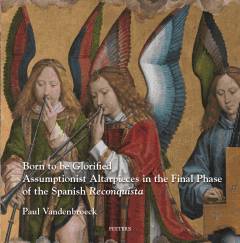
- Retrait gratuit dans votre magasin Club
- 7.000.000 titres dans notre catalogue
- Payer en toute sécurité
- Toujours un magasin près de chez vous
- Retrait gratuit dans votre magasin Club
- 7.000.0000 titres dans notre catalogue
- Payer en toute sécurité
- Toujours un magasin près de chez vous
Born to Be Glorified
Assumptionist Altarpieces in the Final Phase of the Spanish 'Reconquista'
P VandenBroeck
Livre relié | Anglais
55,00 €
+ 110 points
Description
Hans Memling's altarpiece for the high altar of Santa Maria la Real in Najera (1483-1494) must have been one of the most spectacular Flemish art works in the Iberian Peninsula. Only three panels survive in the Antwerp Royal Museum of Fine Arts: God surrounded by singing and music-making angels. The retable's central theme was the mystery of the Assumption of the Blessed Virgin. The iconography of the whole has been described by Jovellanos at the end of the 18th century. From c. 1482 on, dozens of monumental altarpieces dedicated to the Assumption of the Virgin in conjunction with Christological themes have been created throughout Spain. They focus on the complex role of the Holy Virgin, her triumph and glorification. It was a common belief that she was the only human to have borne up bodily into heaven. Although 'Maryam' was held in very high esteem by Muslims too -and as such, she was a interreligious 'bridge'--, her role as Theotokos or Mother of God was a point of conflict. During the last phase of the Reconquista, to Iberian Christians, the Assumption served as an image of the Church/Faith Triumphant, not as a conciliatory belief. Paul Vandenbroeck has worked with the Collection Research Department of the Royal Museum of Fine Arts Antwerp from 1980 to 2018 and he has held a part-time professorship with the Anthropology Research Group IMMRC, Social Sciences Faculty of KU Leuven, since 2003. He is an art graduate from that same university and obtained his PhD in 1986. His main research interests are the oeuvre of Hieronymus Bosch, iconography of early modern art in the Low Countries, iconological questions regarding figurative and abstract art, North African domestic textile art, and topics on the interface between art and anthropology.
Spécifications
Parties prenantes
- Auteur(s) :
- Editeur:
Contenu
- Nombre de pages :
- 156
- Langue:
- Anglais
Caractéristiques
- EAN:
- 9789042949706
- Date de parution :
- 04-10-22
- Format:
- Livre relié
- Format numérique:
- Genaaid
- Dimensions :
- 240 mm x 240 mm
- Poids :
- 1487 g

Les avis
Nous publions uniquement les avis qui respectent les conditions requises. Consultez nos conditions pour les avis.






